Sleep, learning, and school start times in adolescence
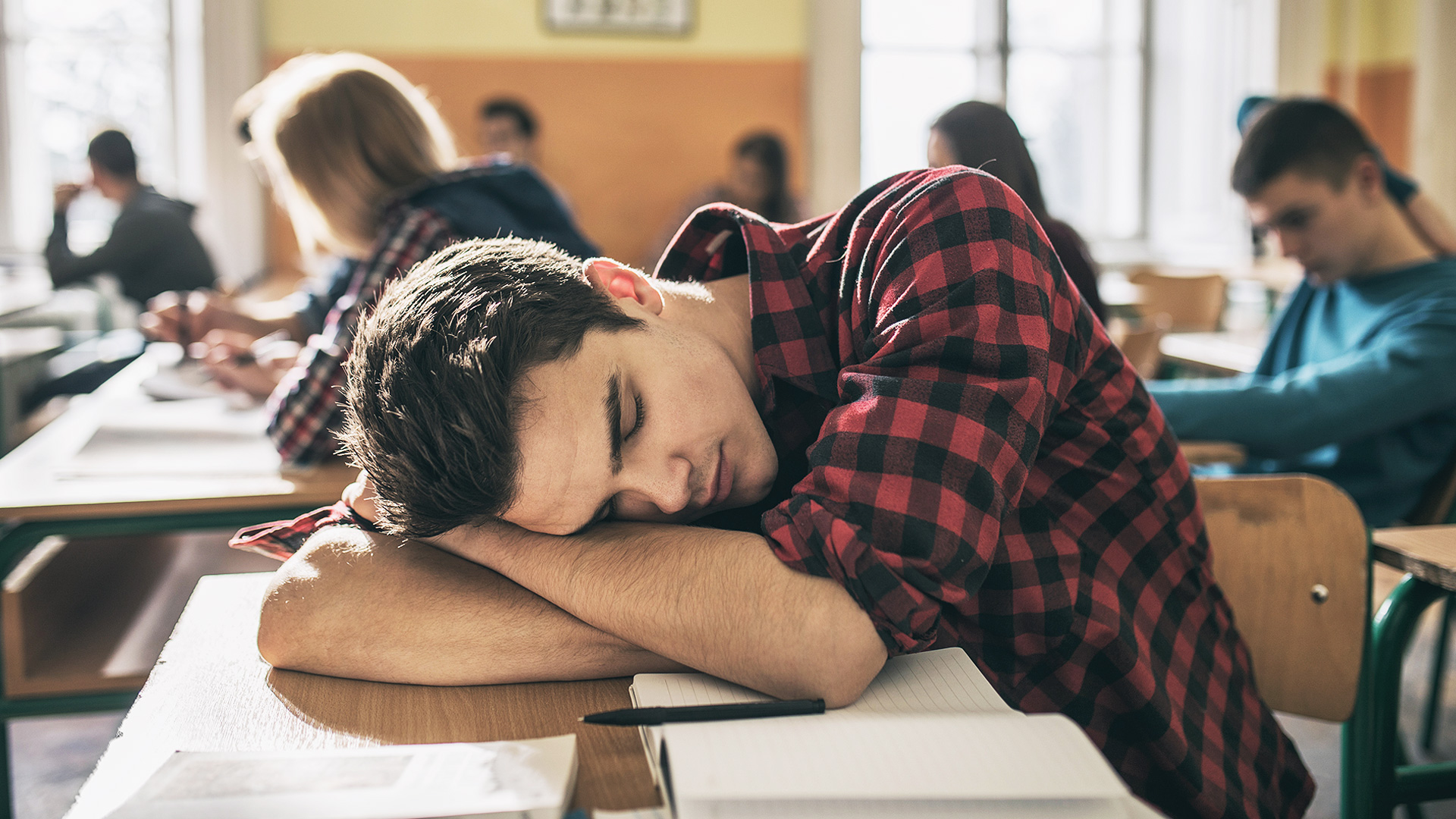
Executive Summary
- Around the start of puberty, adolescents begin to experience a phase delay in their sleep-wake cycle, going to bed later and rising later in the morning
- This phase delay puts adolescent students in conflict with early school start times
- Sleep is crucial for learning and memory
- Chronic sleep loss in adolescents affects learning and memory, as well as a wide range of other outcomes relevant to education and development
- Shifting school start times later may help to mitigate the effects of the phase delay
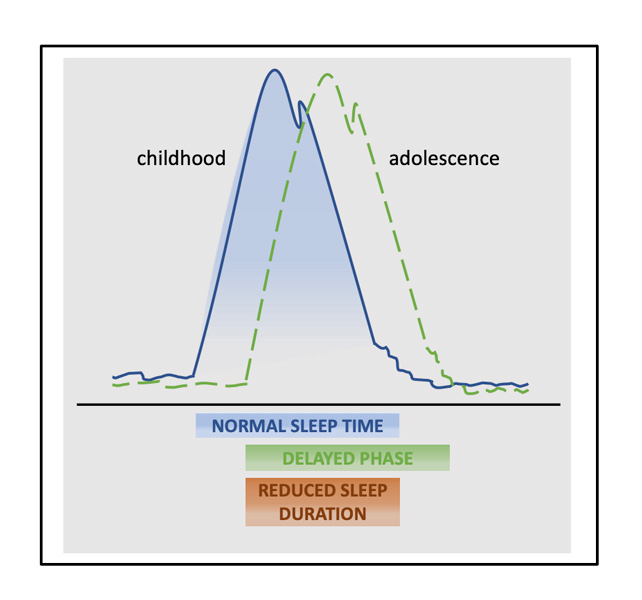
Figure 1. An illustration of the phase delay in the sleep-wake cycle in adolescence, which is related to later release of nocturnal melatonin in the circadian rhythm (as represented by the curves) and slower build-up of sleep pressure. The phase shift results in later bedtimes and reduced sleep duration when adolescents need to rise early in the morning. Based on Figure 4 in ref 3, https://www.frontiersin.org/articles/10.3389/fnmol.2012.00050/full, CC BY-NC
Sleep in adolescence
How many adolescents do you know who joyfully leap out of bed at the first hint of dawn, ready for a new day? Around the start of puberty, most adolescents begin to experience a phase delay in their sleep-wake cycle1-3. As shown in Figure 1, adolescents tend to go to bed later at night and wake up later in the morning, shifting the cycle later by about two hours2,4,5. This phase delay makes teens more like “owls” or “evening types” rather than “larks” or “morning types.” This developmental shift has been observed in adolescents worldwide6-9.
The phase delay is related to both environmental and biological factors10. On the one hand, it is influenced by psychosocial factors that contribute to staying up later, like a desire for independence shown by setting one’s own bedtime. Social opportunities, peer pressure, homework, extracurricular activities, employment, and use of electronic devices can also affect bedtimes6,11-14. Early school start times, which force adolescents to wake up when their bodies still want to be asleep15, p. 64, are an environmental factor that affects wake times.
On the other hand, the phase delay is influenced by neurobiology. Daily (circadian) rhythms are driven by two tiny clusters of neurons called the suprachiasmatic nuclei (SCN), as shown in Figure 2A. Light signals from the eyes are sent to the SCN and then on to the pineal gland, as shown in Figure 2B. The pineal gland produces the sleep-promoting hormone melatonin when light begins to fade. Within the circadian rhythm, the start of melatonin production signals readiness to sleep, and usually precedes bedtime by about an hour16.
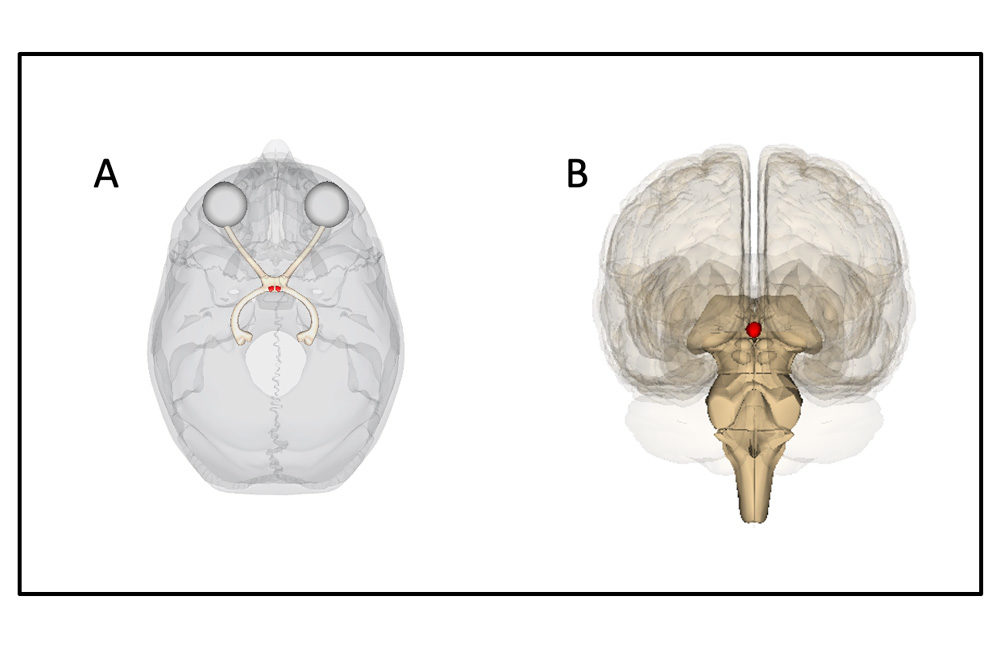
Figure 2. (A) As viewed from above, the tiny suprachiasmatic nuclei (SCN, shaded red) within the hypothalamus are the neural clock that regulates daily (circadian) rhythms. (B) Light signals travel from the eyes to the SCN and then on to the pineal gland (shaded red), which releases the hormone melatonin as light fades. Life Science Databases(LSDB)/Wikimedia Commons, Life Science Databases(LSDB)/Wikimedia Commons, CC BY-SA 2.1 JP
In adolescence, melatonin secretion is delayed until 10:00 PM or later, meaning that teens may not be ready to sleep until at least 11:00 PM6,16,17. Also, the homeostatic “sleep drive” that accumulates across waking hours is slowed in teens. So, biologically, the adolescent phase shift involves both the later release of nocturnal melatonin and the slower build-up of pressure to fall asleep1-3,5,6,10,18,19.
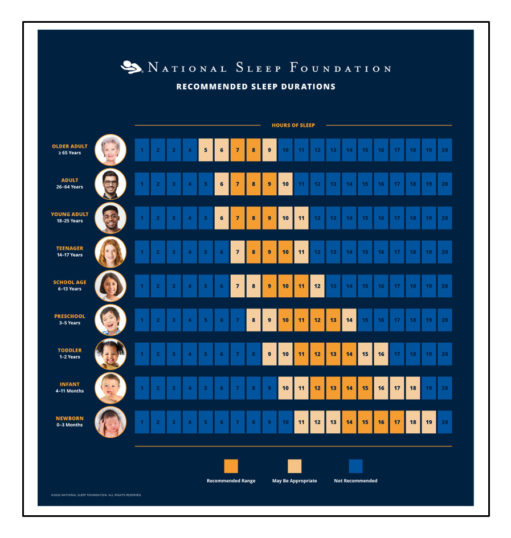
Figure 3. Recommendations for hours of sleep per night by age group from the National Sleep Foundation in the United States. Note that teenagers are recommended to sleep 8 to 10 hours per night. Used with permission from https://www.thensf.org/making-time-for-sleep/.
As noted above, nighttime media use is an environmental factor affecting the phase shift. But electronic media also often emit blue light20. Blue light is especially effective at suppressing melatonin production21. Thus, nighttime media use may directly affect the biology underlying the phase shift by further inhibiting melatonin production and reducing homeostatic rise5,22-25. So messaging with friends late into the night to stay socially connected might also delay sleep biologically.
Although the optimal amount of sleep varies by individual, there are some guidelines26, as in Figure 3. Worldwide, the majority of teens do not obtain the recommended 9 hours of sleep per night12. For example, one study reported that the average amount of sleep on weekdays was 7.4 hours for North American teens, 8.3 hours for European teens, and 7.6 hours for Asian teens8. In a survey of about 3,800 high schoolers in Korea, the students reported an average of 6.4 hours of sleep27. A similar survey of over 22,000 12- to 18-year-olds in Hong Kong found that only about 27% reported getting more than 8 hours of sleep on weekdays28. And in a survey of almost 2,000 Indian 12- to 18-year-olds, students reported an average of 7.8 hours of sleep29. Finally, in a recent CDC survey in the United States30, 78% of high school students reported that they did not get 8 or more hours of sleep on an average school night (https://www.cdc.gov/healthyyouth/data/yrbs/index.htm).
If adolescents fell asleep at 11:00 PM and slept for the recommended average 9 hours, they would wake at 8:00 AM. Because many schools serving adolescents have start times earlier than an 8:00 AM wake-up allows, this puts school schedules in conflict with biology. This means that many adolescent students are sleep deprived and sleepy while in school 31, which has implications for their learning and memory.
Sleep, learning, and memory
In the brain, newly learned information is a fragile memory trace; sleep helps to strengthen and consolidate these fragile memory traces and transform them into more stable long-term memories32-34. Studies with rats and mice have shown that neural circuits that were active during awake learning are active in the same way during sleep35,36, as if the learned material is “replayed” during sleep in order to be strengthened and remembered. Studies with humans have also shown that brain areas involved in a learning task while awake are reactivated during sleep37-39.
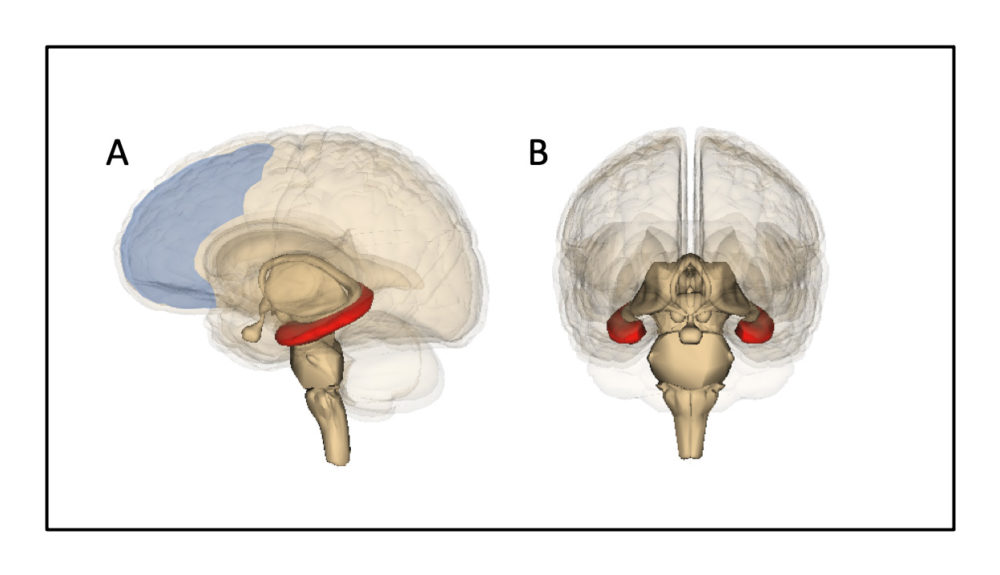
Figure 4. (A) The left hippocampus (shaded red) and the left prefrontal cortex (shaded blue, added) as seen from the side. (B) The left and right hippocampus (shaded red) as seen from the front. Life Science Databases(LSDB)/Wikimedia Commons, CC BY-SA 2.1 JP
At a regional level, this process of memory consolidation involves interactions between the hippocampus and the prefrontal cortex32,34,40, as shown in Figure 4. At a cellular level, memory formation involves strengthening connections between neurons (synapses)41. If a learner is deprived of sleep after initial learning, it interferes with memory consolidation and the newly learned material is less likely to be integrated into long-term memory42. That is, newly learned information is less likely to be remembered without adequate sleep. This is, of course, crucial to education. Although many of the studies on learning, memory, and sleep have been conducted with adults, there is evidence that sleep facilities memory consolidation in children and adolescents in a similar way43,44. For example, in one small study with 27 9- to 12-year-olds, the children learned word pairs and were tested on recall later, both before and after sleep; similar to the pattern observed in adults, memory (in this case, for word pairs) was increased after sleep44.
Effects of insufficient sleep
Given the fundamental role of sleep in learning and memory, it is not surprising that insufficient sleep in adolescents is associated with negative effects on school performance (for reviews, see1,31,45-48). For example, in a study of over 1,000 adolescents in Norway, shorter sleep duration was related to poorer grade-point average (GPA in the lowest quartile); the odds ratio for 6 hours of sleep was 1.21, for 5 hours was 1.54, and for less than 5 hours was 2.5349. Another study of over 380,000 Finnish students aged 14 to 20 found that later bedtimes, especially after 11:30 PM, were associated with poorer school performance50. In this study, school performance was measured by 11 items, from difficulty with teamwork to completing reading tasks50. And in an economic modelling analysis of data from students aged 10 to 19 in the United States, there was a significant positive association between sleep and test scores51. The authors noted that if test scores represent the acquisition of human capital (skills and knowledge correlated with long-term life outcomes), their findings indicate that nonoptimal sleep in adolescence can have lifelong consequences51, p. 522.
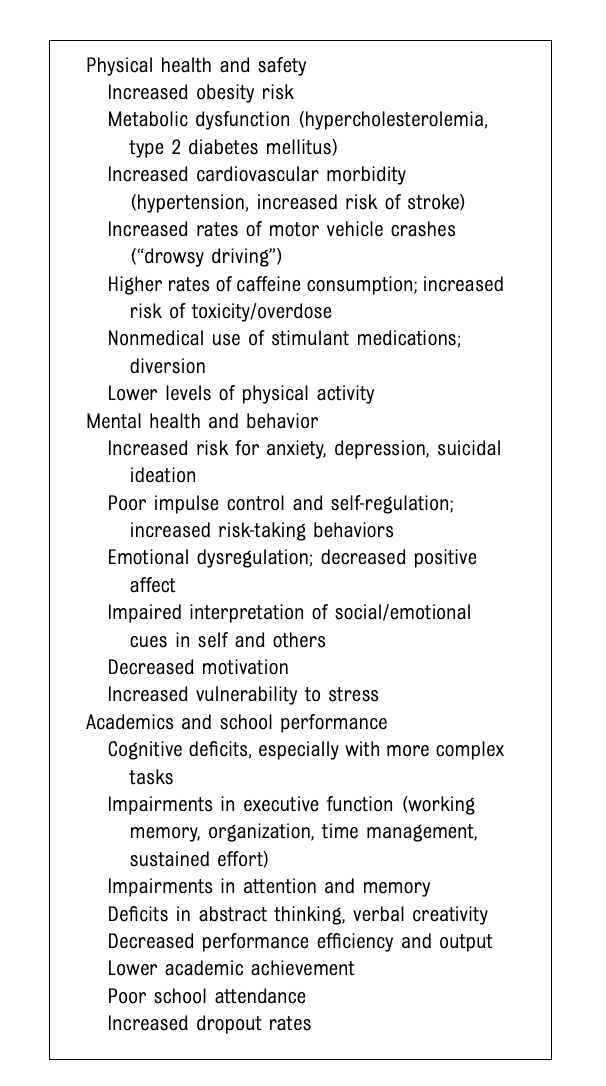
Table 1. The many impacts of inadequate sleep and chronic sleep loss in adolescents ref 1. Reproduced with permission from Journal Pediatrics, Vol. 134, page 643, Copyright © 2014 by the AAP.
Although causal relationships cannot be determined in observational and survey studies, less sleep is associated with daytime sleepiness, which is associated with poor attention and working memory, which are associated with poor school performancee.g., 42,52,53. Some of these links were confirmed in a small study in which 16 adolescents were limited to 6 hours of sleep for five consecutive nights or allowed 10 hours of sleep for five nights54. At the end of each five-night sequence, the adolescents viewed an educational film and took a related quiz in a simulated classroom54. The authors reported both more inattentive behavior and lower quiz scores when the adolescents were sleep-deprived54.
However, chronic sleep loss related to the phase delay in adolescence is not just associated with poorer school performance. Shorter sleep duration affects a stunningly wide range of important developmental outcomes that are relevant to education1, as summarized in Table 1.
If teenagers knew about the extensive and concerning effects of chronic sleep loss, would they change their sleep behaviors? Basic biology cannot be changed, and, unfortunately, most school-based sleep education programs do not seem to be effective. In many55-58, but not all59, studies, such programs might increase knowledge about sleep but do not change behavior. In some studies, small changes in behavior related to intervention (such as sleep time increasing by about 10 minutes) were not maintained at follow-up60,61. However, combining parental involvement and bright light therapy with a sleep education program increased both sleep knowledge and sleep duration (by about 27 minutes) in a study with year 11 students in South Australia62. This research suggests, as educators and policymakers, that we may need to take a closer look at modifiable environmental factors other than sleep itself.
School start times
Early school start times contribute to short sleep duration in adolescents. The resulting chronic sleep loss affects both their education and their health. Based on the scientific evidence regarding sleep in adolescents, in just the United States alone, the American Academy of Pediatrics, National Association of School Nurses, Society of Pediatric Nurses, American Medical Association, and American Academy of Sleep Medicine have all endorsed secondary schools starting no earlier than 8:30 AM1,63-65.
Start times are an environmental contributor to insufficient sleep in adolescents that can be changed1. Through policy decisions, we can reduce or remove the detrimental effects of early school start times. Indeed, school districts worldwide have delayed start times to address chronic sleep deprivation and its effects on adolescents7,66. However, only about 18% of public schools serving adolescents in the United States started at 8:30 AM or later in 2011-201267. California has only recently become the first state to mandate that all public high schools start no earlier than 8:30 AM (and middle schools start no earlier than 8:00 AM) by the 2022-2023 school year68.
Research consistently shows that adolescent students sleep longer on weeknights when schools shift to later start times7,65,69-87. Much of this research has been conducted in the United States. For example, in one study, delaying school start time by 30 minutes (from 8:00 to 8:30 AM) was associated with an increase of 45 minutes of sleep on school nights72. This study included about 200 grade 9 through 12 students at an independent high school in the United States who self-reported on their sleep 72. The percentage of students getting less than 7 hours of sleep decreased by almost 80% and the percentage of students getting at least 8 hours of sleep increased from about 16% to about 55%72. In a similar study, sleep duration reverted back to baseline levels when the earlier school start time was reinstated82. Another study used a more direct measure of sleep (actigraphy, a wristwatch that records movement) with 383 15-year-olds in the United States88. In this study, students in schools that started at 8:30 AM or later slept about 34 minutes longer than students in schools that started before 7:30 AM, and about 23 minutes longer than students in schools that started between 7:30 and 7:59 AM88. In another study using actigraphy, 455 students in five American public high schools were followed as two of the schools delayed their start times (by 50 and 65 minutes) while the other three kept a 7:30 AM start time77. In comparison to students in schools with an unchanged 7:30 AM start, students who attended the delayed-start schools gained about 40 minutes of school-night sleep77. This effect was sustained over two years77. With a control group, this study design allows for the conclusion that delaying start times caused students to get more sleep77. So delaying school start times accomplishes the goal of increasing the amount of sleep that adolescents get on school nights. In addition, students report being less sleepy during the day when start times are shifted later7,65,70-72,74,78,81,83,84.
Delayed start times have also been associated with better student achievement, as measured by grades or test scores, in many15,52,75,76,80,86,89,90, but not all69,91-93, studies. For example, one study analyzed grade 6 through 8 (middle school) data from a single county in North Carolina89,94. Delaying start time by one hour (from 7:30 to 8:30 AM) was associated with an increase in standardized test scores of about 2 percentile points in math and 1.5 percentile points in reading89,94. These effects were largest for the lowest-scoring students (more than twice as large for the students in the bottom third of the score distribution than the top third)89,94. Another study looked at the effects of delaying start time to 10:00 AM at a state-funded high school in England90. This delay was related to a 12% increase in students making good academic progress, as measured by performance on national exams90. Performance in the first class of the day may be particularly affected, through less tardiness15,95,96. In an economic analysis of start time data, Jacob and Rockoff97 estimated a 1:9 cost-benefit ratio for later school start times in middle and high schools. They also estimated an average increase in student achievement of about 0.175 standard deviations for shifting start times one hour later in grades 6 through 1297. This converted to about $17,500 in increased earning potential per student97.
A review of 17 studies across six countries (Brazil, Canada, Croatia, Israel, New Zealand, and the United States) concluded that later school start times appear to increase sleep duration and are positively associated with academic outcomes66. However, the authors noted that higher quality studies and more evidence are needed to determine the causal effects of later school start times with confidence66. The use of self-report, convenience samples (including small sample sizes in terms of both students and schools), and inconsistent outcome measures and the lack of control groups in many early studies weaken the conclusions that can be drawn66,74,78. More recent studies have addressed some of these issuese.g., 77. However, implementing large, randomized controlled trials that would allow for clear causal conclusions regarding the effects of delayed start times may be unfeasible98.
This is in part because shifting to later start times can be administratively and logistically challenging for schools and districts. Educating students and parents about adolescent sleep needs, learning about the research on school start times, sharing the positive experiences of communities that have made the transition, and considering the limited extent of adverse effects may be key to gaining stakeholder support99. It is also important to directly address concerns about sports, other afterschool activities, employment, and transportation, which are often perceived as barriers to delaying start times100. Guidance for this process is availablee.g., 101.
Based on data from the United States, macroeconomic models suggest that shifting school start times to 8:30 AM is a cost-effective population-level strategy102. This strategy not only has significant positive impact on public health but also shows significant economic gains relatively soon after implementation102. Overall, delaying school start times allows adolescent students to sleep longer and come to school more ready to learn and remember, better preparing them to become contributing members of society.
References
- Adolescent Sleep Working Group, Committee on Adolescence & Council on School Health. School start times for adolescents. Pediatrics 134, 642-649, doi:10.1542/peds.2014-1697 (2014).
- Crowley, S. J., Acebo, C. & Carskadon, M. A. Sleep, circadian rhythms, and delayed phase in adolescence. Sleep Medicine 8, 602-612, doi:10.1016/j.sleep.2006.12.002 (2007).
- Wright, K. P., Lowry, C. A. & LeBourgeois, M. K. Circadian and wakefulness-sleep modulation of cognition in humans. Frontiers in Molecular Neuroscience 5, 1-12, doi:10.3389/fnmol.2012.00050 (2012).
- Frey, S., Balu, S., Greusing, S., Rothen, N. & Cajochen, C. Consequences of the timing of menarche on female adolescent sleep phase preference. PLoS ONE 4, e5217, doi:10.1371/journal.pone.0005217 (2009).
- Hagenauer, M. H., Perryman, J. I., Lee, T. M. & Carskadon, M. A. Adolescent changes in the homeostatic and circadian regulations of sleep. Dev. Neurosci. 31, 276-284, doi:10.1159/000216538 (2009).
- Carskadon, M. A., Acebo, C. & Jenni, O. G. Regulation of adolescent sleep: implications for behavior. Ann. N. Y. Acad. Sci. 1021, 276-291, doi:10.1196/annals.1308.032 (2004).
- Alfonsi, V., Scarpelli, S., D’Atri, A., Stella, G. & De Gennaro, L. Later school start times: the impact of sleep on academic performance and health in the adolescent population. International Journal of Environmental Research and Public Health 17, 1-16, doi:10.3390/ijerph17072574 (2020).
- Gradisar, M., Gardner, G. & Dohnt, H. Recent worldwide sleep patterns and problems during adolescence: a review and meta-analysis of age, region, and sleep. Sleep Medicine 12, 110-118, doi:10.1016/j.sleep.2010.11.008 (2011).
- Saxvig, I. W., Pallesen, S., Wilhelmsen-Langeland, A., Molde, H. & Bjorvatn, B. Prevalence and correlates of delayed sleep phase in high school students. Sleep Medicine 13, 193-199, doi:10.1016/j.sleep.2011.10.024 (2012).
- Carskadon, M. A. Sleep in adolescents: the perfect storm. Pediatr. Clin. North Am. 58, 637-647, doi:10.1016/j.pcl.2011.03.003 (2011).
- Carskadon, M. A., Wolfson, A. R., Acebo, C., Tzischinsky, O. & Seifer, R. Adolescent sleep patterns, circadian timing, and sleepiness at a transition to early school days. Sleep 21, 871-881, doi:10.1093/sleep/21.8.871 (1998).
- Moore, M. & Meltzer, L. J. The sleepy adolescent: causes and consequences of sleepiness in teens. Paediatric Respiratory Reviews 9, 114-121, doi:10.1016/j.prrv.2008.01.001 (2008).
- Dube, N., Khan, K., Loehr, S., Chu, Y. & Veugelers, P. The use of entertainment and communication technologies before sleep could affect sleep and weight status: a population-based study among children. International Journal of Behavioral Nutrition and Physical Activity 14, 1-15, doi:10.1186/s12966-017-0547-2 (2017).
- Dworak, M., Schierl, T., Bruns, T. & Strüder, H. K. Impact of singular excessive computer game and television exposure on sleep patterns and memory performance of school-aged children. Pediatrics 120, 978-985, doi:10.1542/peds.2007-0476 (2007).
- Carrell, S. E., Maghakian, T. & West, J. E. A’s from Zzzz’s? The causal effect of school start time on the academic achievement of adolescents. American Economic Journal 3, 62-71, doi:10.1257/pol.3.3.62 (2011).
- Lamberg, L. High schools find later start time helps students’ health and performance. Journal of the American Medical Association 301, 2200-2201, doi:10.1001/jama.2009.786 (2009).
- Carskadon, M. A., Acebo, C., Richardson, G. S., Tate, B. A. & Seifer, R. An approach to studying circadian rhythms of adolescent humans. J. Biol. Rhythms 12, 278-289, doi:10.1177/074873049701200309 (1997).
- Taylor, D. J., Jenni, O. G., Acebo, C. & Carskadon, M. A. Sleep tendency during extended wakefulness: insights into adolescent sleep regulation and behavior. J. Sleep Res. 14, 239-244, doi:10.1111/j.1365-2869.2005.00467.x (2005).
- Jenni, O. G., Achermann, P. & Carskadon, M. A. Homeostatic sleep regulation in adolescents. Sleep 28, 1446-1454, doi:10.1093/sleep/28.11.1446 (2005).
- Oh, J. H., Yoo, H., Park, H. K. & Do, Y. R. Analysis of circadian properties and healthy levels of blue light from smartphones at night. Scientific Reports 5, 1-9, doi:10.1038/srep11325 (2015).
- Lockley, S. W., Brainard, G. C. & Czeisler, C. A. High sensitivity of the human circadian melatonin rhythm to resetting by short wavelength light. The Journal of Clinical Endocrinology & Metabolism 88, 4502-4505, doi:10.1210/jc.2003-030570 (2003).
- Skeldon, A. C., Phillips, A. J. K. & Dijk, D.-J. The effects of self-selected light-dark cycles and social constraints on human sleep and circadian timing: a modeling approach. Scientific Reports 7, 1-14, doi:10.1038/srep45158 (2017).
- Touitou, Y., Touitou, D. & Reinberg, A. Disruption of adolescents’ circadian clock: the vicious circle of media use, exposure to light at night, sleep loss and risk behaviors. Journal of Physiology – Paris 110, 467-479, doi:10.1016/j.jphysparis.2017.05.001 (2016).
- Bartel, K. A., Gradisar, M. & Williamson, P. Protective and risk factors for adolescent sleep: a meta-analytic review. Sleep Medicine Reviews 21, 72-85, doi:10.1016/j.smrv.2014.08.002 (2015).
- Chang, A.-M., Aeschbach, D., Duffy, J. F. & Czeisler, C. A. Evening use of light-emitting eReaders negatively affects sleep, circadian timing, and next-morning alertness. Proceedings of the National Academy of Sciences 112, 1232-1237, doi:10.1073/pnas.1418490112 (2015).
- Paruthi, S. et al. Recommended amount of sleep for pediatric populations: a consensus statement of the American Academy of Sleep Medicine. Journal of Clinical Sleep Medicine 12, 785-786, doi:10.5664/jcsm.5866 (2016).
- Shin, C., Kim, J., Lee, S., Ahn, Y. & Joo, S. Sleep habits, excessive daytime sleepiness and school performance in high school students. Psychiatry Clin. Neurosci. 57, 451-453, doi:10.1046/j.1440-1819.2003.01146.x (2003).
- Mak, K.-K., Lee, S.-L., Ho, S.-Y., Lo, W.-S. & Lam, T.-H. Sleep and academic performance in Hong Kong adolescents. J. Sch. Health 82, 522-527, doi:10.1111/j.1746-1561.2012.00732.x (2012).
- Gupta, R. et al. Sleep patterns of urban school-going adolescents. Indian Pediatr. 45, 183-189 (2008).
- Underwood, J. M. et al. Overview and methods for the Youth Risk Behavior Surveillance System – United States, 2019. MMWR 69, 1-10, doi:10.15585/mmwr.su6901a1external icon (2020).
- Curcio, G., Ferrara, M. & De Gennaro, L. Sleep loss, learning capacity and academic performance. Sleep Medicine Reviews 10, 323-337, doi:10.1016/j.smrv.2005.11.001 (2006).
- Born, J., Rasch, B. & Gais, S. Sleep to remember. The Neuroscientist 12, 410-424, doi:10.1177/1073858406292647 (2006).
- Walker, M. P. & Stickgold, R. Sleep, memory, and plasticity. Annu. Rev. Psychol. 57, 139-166, doi:10.1146/annurev.psych.56.091103.070307 (2006).
- Gais, S. et al. Sleep transforms the cerebral trace of declarative memories. Proceedings of the National Academy of Sciences 104, 18778-18783, doi:10.1073/pnas.0705454104 (2007).
- McNaughton, B. L. et al. Off-line reprocessing of recent memory and its role in memory consolidation: a progress report, in Sleep and brain plasticity (eds P. Maquet, C. Smith, & R. Stickgold) Ch. 12, 225-246 (Oxford University Press, 2003).
- Yang, G. et al. Sleep promotes branch-specific formation of dendritic spines after learning. Science 344, doi:10.1126/science.1249098 (2007).
- Maquet, P. et al. Experience-dependent changes in cerebral activation during human REM sleep. Nat. Neurosci. 3, 831-836, doi:10.1038/77744 (2000).
- Rasch, B. & Born, J. Reactivation and consolidation of memory during sleep. Current Directions in Psychological Science 17, 188-192, doi:10.1111/j.1467-8721.2008.00572.x (2008).
- Huber, R., Ghilardi, M. F., Massimini, M. & Tononi, G. Local sleep and learning. Nature 430, 78-81, doi:10.1038/nature02663 (2004).
- Preston, A. R. & Eichenbaum, H. Interplay of hippocampus and prefrontal cortex in memory. Curr. Biol. 23, R764-R773, doi:10.1016/j.cub.2013.05.041 (2013).
- Tononi, G. & Cirelli, C. Sleep and the price of plasticity: from synaptic and cellular homeostasis to memory consolidation and integration. Neuron 81, 12-34, doi:10.1016/j.neuron.2013.12.025 (2014).
- de Bruin, E. J., can Run, C., Staaks, J. & Meijer, A. M. Effects of sleep manipulation on cognitive functioning of adolescents: a systematic review. Sleep Medicine Reviews 32, 45-57, doi:10.1016/j.smrv.2016.02.006 (2017).
- Kopasz, M. et al. Sleep and memory in healthy children and adolescents – a critical review. Sleep Medicine Reviews 14, 167-177, doi:10.1016/j.smrv.2009.10.006 (2010).
- Backhaus, J., Hoeckesfeld, R., Born, J., Hohagen, F. & Junghanns, K. Immediate as well as delayed post learning sleep but not wakefulness enhances declarative memory consolidation in children. Neurobiol. Learn. Mem. 89, 76-80, doi:10.1016/j.nlm.2007.08.010 (2008).
- Shochat, T., Cohen-Zion, M. & Tzischinsky, O. Functional consequences of inadequate sleep in adolescents: a systematic review. Sleep Medicine Reviews 18, 75-87, doi:10.1016/j.smrv.2013.03.005 (2014).
- Dewald, J. F., Meijer, A. M., Oort, F. J., Kerkhof, G. A. & Bögels, S. M. The influence of sleep quality, sleep duration and sleepiness on school performance in children and adolescents: a meta-analytic review. Sleep Medicine Reviews 14, 179-189, doi:10.1016/j.smrv.2009.10.004 (2010).
- Taras, H. & Potts-Datema, W. Sleep and student performance at school. J. Sch. Health 7, 248-254, doi:10.1111/j.1746-1561.2005.tb06685.x (2005).
- Wolfson, A. R. & Carskadon, M. A. Understanding adolescents’ sleep patterns and school performance: a critical appraisal. Sleep Medicine Reviews 7, 491-506, doi:10.1016/s1087-0792(03)90003-7 (2003).
- Hysing, M., Harvey, A. G., Linton, S. J., Askeland, K. G. & Sivertsen, B. Sleep and academic performance in later adolescence: results from a large population-based study. J. Sleep Res. 25, 318-324, doi:10.1111/jsr.12373 (2016).
- Merikanto, I., Lahti, T., Puusniekka, R. & Partonen, T. Late bedtimes weaken school performance and predispose adolescents to health hazards. Sleep Medicine 14, 1105-1111, doi:10.1016/j.sleep.2013.06.009 (2013).
- Eide, E. R. & Showlater, M. H. Sleep and student achievement. Eastern Economic Journal 38, 512-524, doi:10.1057/eej.2011.33 (2012).
- Perez-Lloret, S. et al. A multi-step pathway connecting short sleep duration to daytime somnolence, reduced attention, and poor academic performance: an exploratory cross-sectional study in teenagers. Journal of Clinical Sleep Medicine 9, 469-473, doi:10.5664/jcsm.2668 (2013).
- Banks, S. & Dinges, D. F. Behavioral and physiological consequences of sleep restriction. Journal of Clinical Sleep Medicine 3, 519-528, doi:10.5664/jcsm.26918 (2007).
- Beebe, D. W., Rose, D. & Amin, R. Attention, learning, and arousal of experimentally sleep-restricted adolescents in a simulated classroom. J. Adolesc. Health 47, 523-525, doi:10.1016/j.jadohealth.2010.03.005 (2010).
- Blunden, S. L., Chapman, J. & Rigney, G. A. Are sleep education programs successful? The case for improved and consistent research efforts. Sleep Medicine Reviews 16, 355-370, doi:10.1016/j.smrv.2011.08.002 (2012).
- Cassoff, J., Knäuper, B., Michaelsen, S. & Griuber, R. School-based sleep promotion programs: effectiveness, feasibility and insights for future research. Sleep Medicine Reviews 17, 207-214, doi:10.1016/j.smrv.2012.07.001 (2013).
- Cain, N., Gradisar, M. & Moseley, L. A motivational school-based intervention for adolescent sleep problems. Sleep Medicine 12, 241-251, doi:10.1016/j.sleep.2010.06.008 (2011).
- Moseley, L. & Gradisar, M. Evaluation of a school-based intervention for adolescent sleep problems. Sleep 32, 334-341, doi:10.1093/sleep/32.3.334 (2009).
- Sousa, I. C., Souza, J. C., Louzada, F. M. & Azevedo, C. V. M. Changes in sleep habits and knowledge after an educational sleep program in 12th grade students. Sleep and Biological Rhythms 11, 144-153, doi:10.1111/sbr.12016 (2013).
- Rigney, G. et al. Can a school-based sleep education programme improve sleep knowledge, hygiene and behaviours using a randomised controlled trial. Sleep Medicine 16, 736-745, doi:10.1016/j.sleep.2015.02.534 (2015).
- Wolfson, A. R., Harkins, E., Johnson, M. & Marco, C. Effects of Young Adolescent Sleep Smart Program on sleep hygiene practices, sleep health efficacy, and behavioral well-being. Sleep Health 1, 197-204, doi:10.1016/j.sleh.2015.07.002 (2015).
- Bonnar, D. et al. Evaluation of novel school-based interventions for adolescent sleep problems: does parental involvement and bright light improve outcomes? Sleep Health 1, 66-74, doi:10.1016/j.sleh.2014.11.002 (2015).
- National Association of School Nurses and Society of Pediatric Nurses. Consensus statement: early school start times. (National Association of School Nurses and Society of Pediatric Nurses, Silver Springs, MD, 2014).
- AMA Media & Editorial. https://www.ama-assn.org/press-center/press-releases/ama-supports-delayed-school-start-times-improve-adolescent-wellness (2016).
- Watson, N. F. et al. Delaying middle school and high school start times promotes student health and performance: an American Academy of Sleep Medicine position statement. Journal of Clinical Sleep Medicine 13, 623-625, doi:10.5664/jcsm.6558 (2017).
- Marx, R. W. et al. Later school start times for supporting the education, health, and well-being of high school students: a systematic review. (Campbell Collaborative, 2017).
- Wheaton, A. G., Ferro, G. A. & Croft, J. B. School start times for middle school and high school students – United States, 2011-12 school year. Morbidity and Mortality Weekly Report 64, 809-834, doi:10.15585/mmwr.mm6430a1 (2015).
- Daugherty, O. California becomes first state to mandate later start times at public schools. The Hill (2019).
- Wahlstrom, K. Changing times: findings from the first longitudinal study of later high school start times. NASSP Bulletin 86, 3-21, doi:10.1177/019263650208663302 (2002).
- Wolfson, A. R., Spaulding, N. L., Dandrow, C. & Baroni, E. M. Middle school start times: the importance of a good night’s sleep for young adolescents. Behavioral Sleep Medicine 5, 194-209, doi:10.1080/15402000701263809 (2007).
- Dexter, D., Bijwadia, J., Schilling, D. & Applebaugh, G. Sleep, sleepiness and school start times: a preliminary study. Wis. Med. J. 102, 44-46 (2003).
- Owens, J. A., Belon, K. & Moss, P. Impact of delaying school start time on adolescent sleep, mood, and behavior. Arch. Pediatr. Adolesc. Med. 164, 608-614, doi:10.1001/archpediatrics.2010.96 (2010).
- Danner, F. & Phillips, B. Adolescent sleep, school start times, and teen motor vehicle crashes. Journal of Clinical Sleep Medicine 4, 533-535, doi:10.5664/jcsm.27345 (2008).
- Minges, K. E. & Redeker, N. S. Delayed school start times and adolescent sleep: a systematic review of the experimental evidence. Sleep Medicine Reviews 28, 86-95, doi:10.1016/j.smrv.2015.06.002 (2016).
- Wheaton, A. G., Chapman, D. P. & Croft, J. B. School start times, sleep, behavioral, health, and academic outcomes: a review of the literature. J. Sch. Health 86, 363-381, doi:10.1111/josh.12388 (2016).
- Wahlstrom, K. L. et al. Examining the impact of later high school start times on the health and academic performance of high school students: a multi-site study. (University of Minnesota, St. Paul, MN, 2014).
- Widome, R. et al. Association of delaying school start time with sleep duration, timing, and quality among adolescents. JAMA Pediatrics 174, 697-704, doi:10.1001/jamapediatrics.2020.0344 (2020).
- Morgenthaler, T. I. et al. High school start times and the impact on high school students: what we know, and what we hope to learn. Journal of Clinical Sleep Medicine 12, 1681-1689, doi:10.5664/jcsm.6358 (2016).
- Patte, K. A., Cole, A. G., Qian, W. & Leatherdale, S. T. Youth sleep durations and school start times: a cross-sectional analysis of the COMPASS study. Sleep Health 3, 432-436, doi:10.1016/j.sleh.2017.07.011 (2017).
- Perkinson-Gloor, N., Lemola, S. & Grob, A. Sleep duration, positive attitude toward life, and academic achievement: the role of daytime tiredness, behavioral persistence, and school start times. J. Adolesc. 36, 311-318, doi:10.1016/j.adolescence.2012.11.008 (2013).
- Temkin, D. A., Princiotta, D., Ryberg, R. & Lewin, D. S. Later start, longer sleep: implications of middle school start times. J. Sch. Health 88, 370-378, doi:10.1111/josh.12622 (2018).
- Boergers, J., Gable, C. J. & Owens, J. A. Later school start times is associated with improved sleep and daytime functioning in adolescents. J. Dev. Behav. Pediatr. 35, 11-17, doi:10.1097/DBP.0000000000000018 (2014).
- Owens, J. A., Dearth-Wesley, T., Herman, A. N., Oakes, J. M. & Whitaker, R. C. A quasi-experimental study of the impact of school start time changes on adolescent sleep. Sleep Health 3, 437-443, doi:10.1016/j.sleh.2017.09.001 (2017).
- Borlase, B. J., Gander, P. H. & Gibson, R. H. Effects of school start times and technology use on teenagers’ sleep: 1999-2008. Sleep and Biological Rhythms 11, 46-54, doi:10.1111/sbr.12003 (2013).
- Mitru, G., Millrood, D. L. & Mateika, J. H. The impact of sleep on learning and behavior in adolescents. Teachers College Record 104, 704-726, doi:10.1111/1467-9620.00176 (2002).
- Dunster, G. P. et al. Sleepmore in Seattle: Later school start times are associated with more sleep and better performance in high school students. Science Advances 4, eaau6200, doi:10.1126/sciadv.aau6200 (2018).
- Lufi, D., Tzischinsky, O. & Hadar, S. Delaying school start times by one hour: some effects on attention levels in adolescents. Journal of Clinical Sleep Medicine 7, 137-143, doi:10.5664/jcsm.28100 (2011).
- Nahmod, N. G. et al. Later high school start times associated with longer actigraphic sleep duration in adolescents. Sleep 42, 1-10, doi:10.1093/sleep/zsy212 (2019).
- Edwards, F. Early to rise? The effect of daily start times on academic performance. Economics of Education Review 31, 970-983, doi:10.1016/j.econedurev.2012.07.006 (2012).
- Kelley, P., Lockley, S. W., Kelley, J. & Evans, M. D. R. Is 8:30 a.m. still too early to start school? A 10:00 a.m. school start time improves health and performance of students aged 13-16. Frontiers in Human Neuroscience 11, 1-10, doi:10.3389/fnhum.2017.00588 (2017).
- Hinrichs, P. Then the bell tolls: the effects of school starting times on academic achievement. Education Finance and Policy 6, 486-507, doi:10.1162/EDFP_a_00045 (2011).
- Eliasson, A., Eliasson, A., King, J., Gould, B. & Eliasson, A. Association of sleep and academic performance. Sleep and Breathing 6, 45-48, doi:10.1055/s-2002-23157 (2002).
- Thacher, P. V. & Onyper, S. V. Longitudinal outcomes of start time delay on sleep, behavior, and achievement in high school. Sleep 39, 271-281, doi:10.5665/sleep.5426 (2016).
- Edwards, F. Do schools begin too early? Education Next 12, 53-57 (2012).
- Cortes, K. E., Bricker, J. & Rohlfs, C. The role of specific subjects in education production functions: evidence from morning classes in Chicago public high schools. The B.E. Journal of Economic Analysis & Policy 12, 27, doi:10.1515/1935-1682.2749 (2012).
- Hansen, M., Janssen, I., Schiff, A., Zee, P. C. & Dubocovich, M. L. The impact of school daily schedule on adolescent sleep. Pediatrics 115, 1555-1561, doi:10.1542/peds.2004-1649 (2005).
- Jacob, B. A. & Rockoff, J. E. Organizing schools to improve student achievement: start times, grade configurations, and teacher assignments. (The Hamilton Project/Brookings, Washington, DC, 2011).
- Illingworth, G. et al. Challenges in implementing and assessing outcomes of school start time change in the UK: experience of the Oxford Teensleep study. Sleep Medicine 60, 89-95, doi:10.1016/j.sleep.2018.10.021 (2019).
- Dunietz, G. L. et al. Later school start times: what informs parent support and opposition? Journal of Clinical Sleep Medicine 13, 889-897, doi:10.5664/jcsm.6660 (2017).
- Wolfson, A. R. & Carskadon, M. A. A survey of factors influencing high school start times. NASSP Bulletin 89, 47-63 (2005).
- Owens, J., Drobnich, D., Baylor, A. & Lewin, D. School start time change: an in-depth examination of school districts in the United States. Mind, Brain, and Education 8, 182-213, doi:10.1111/mbe.12059 (2014).
- Hofner, M., Stepanek, M. & Troxel, W. M. The economic implications of later school start times in the United States. Sleep Health 3, 451-457, doi:10.1016/j.sleh.2017.08.007 (2017).